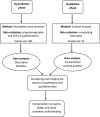Challenges of smoking cessation in users of non-invasive stimulation technologies in Iran: a parallel convergent mixed-methods study
- PMID: 39725436
- PMCID: PMC11683994
- DOI: 10.1136/bmjopen-2024-091253
Challenges of smoking cessation in users of non-invasive stimulation technologies in Iran: a parallel convergent mixed-methods study
Abstract
Objectives: In recent years, non-invasive stimulation technologies such as repetitive transcranial magnetic stimulation, transcranial direct current stimulation, bioresonance and auriculotherapy have been used for smoking cessation. Individuals may face various challenges throughout the quitting process. This study aimed to explore the challenges of smoking cessation for users of non-invasive stimulation technologies in Iran.
Design, setting and participants: This parallel-convergent mixed-methods study was conducted using both quantitative and qualitative components. In the quantitative component, a cross-sectional study involved 400 participants, randomly and proportionally sampled from clinics offering non-invasive stimulation technologies for smoking cessation. Data were collected through questionnaires on sociodemographic characteristics and the Challenges to Stopping Smoking scale, with descriptive statistics used for analysis. Participants ranked the challenges based on a predetermined list in the quantitative component. In the qualitative component, 25 users from Tehran, Tabriz and Karaj were selected via purposive and snowball sampling. Data were gathered through in-depth, semistructured individual interviews and analysed using qualitative content analysis with a conventional approach. A merging strategy and convergence model were employed to combine the quantitative and qualitative data.
Results: Quantitative results indicated that 71.5% of participants ranked fear of side effects as a major challenge, making it the most significant issue. Qualitative data also highlighted this, as the primary challenge in smoking cessation. 242 (60.5%) participants declared fear of failure as one of the main challenges. Qualitative data indicated that this often stems from previous unsuccessful quit attempts. The feeling of losing cigarettes was one of the major challenges for 129 (32.2%) participants, reflecting a deep emotional dependency on smoking. While the concern about the cost of using the technology was one of the major challenges for 76 (19.0%) of the participants, qualitative data provided a different perspective, with some participants assessing the high cost of quitting against potential future savings from not buying cigarettes. Fear of relapse was a notable challenge identified in the qualitative data, underscoring the importance of managing triggers and environments during the cessation process.
Conclusions: Fear of side effects and failure were the most significant challenges in smoking cessation using non-invasive stimulation technologies. Emotional dependency on cigarettes and concerns about the cost also played a role. Fear of relapse was highlighted in qualitative data. To overcome the challenges of smoking cessation with non-invasive stimulation technologies, supportive programmes that provide psychological counselling, financial aid and education are essential to improve success rates.
Keywords: PUBLIC HEALTH; Smoking Reduction; Tobacco Use.
© Author(s) (or their employer(s)) 2024. Re-use permitted under CC BY-NC. No commercial re-use. See rights and permissions. Published by BMJ Group.
Conflict of interest statement
Competing interests: None declared.
Figures

Similar articles
-
Preferences of Iranian smokers regarding smart smoking cessation technologies: a parallel convergent mixed methods study.BMC Public Health. 2024 Aug 9;24(1):2163. doi: 10.1186/s12889-024-19708-y. BMC Public Health. 2024. PMID: 39123187 Free PMC article.
-
Smoking cessation program preferences of individuals with chronic obstructive pulmonary disease: a qualitative study.Prim Health Care Res Dev. 2024 Sep 20;25:e38. doi: 10.1017/S1463423624000306. Prim Health Care Res Dev. 2024. PMID: 39301597 Free PMC article.
-
Utilisation of smoking cessation aids among South African adult smokers: findings from a national survey of 18 208 South African adults.Fam Med Community Health. 2021 Jan;9(1):e000637. doi: 10.1136/fmch-2020-000637. Fam Med Community Health. 2021. PMID: 33431587 Free PMC article.
-
Motivational support intervention to reduce smoking and increase physical activity in smokers not ready to quit: the TARS RCT.Health Technol Assess. 2023 Mar;27(4):1-277. doi: 10.3310/KLTG1447. Health Technol Assess. 2023. PMID: 37022933 Free PMC article.
-
Interventions for waterpipe smoking cessation.Cochrane Database Syst Rev. 2023 Jun 7;6(6):CD005549. doi: 10.1002/14651858.CD005549.pub4. Cochrane Database Syst Rev. 2023. PMID: 37286509 Free PMC article. Review.
References
MeSH terms
LinkOut - more resources
Full Text Sources
Medical
